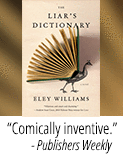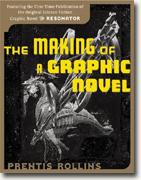The Making of a Graphic Novel: The Resonator
Prentis Rollins
book reviews:
· general fiction
· chick lit/romance
· sci-fi/fantasy
· graphic novels
· nonfiction
· audio books
· author interviews
· children's books @
curledupkids.com
· DVD reviews @
curledupdvd.com
newsletter
win books
buy online
links
home
for authors
& publishers
for reviewers

 |
The Making of a Graphic Novel/ The Resonator Prentis Rollins Watson-Guptill Paperback 168 pages January 2006 |
|
Both a graphic novel and an excavation of the elements in a graphic novel, this work by Prentis Rollins proves to both an entertaining and valuable tool for those of us interested in the world of comic books, sequential art, and graphic novels. As recommended in the beginning of the book, one should read the ninety-six page graphic novel The Resonator first and follow it up with reading The Making of a Graphic Novel, so that when the text references the story, readers will understand and recognize the points being made.
Delivered in the famous in medias res style of epics, The Resonator relays an exciting, bold tale set in a bleak but scientifically advanced universe. Bronsenís temporal exploits are counterbalanced with dream sequences where he encounters the Resonator in a kind of Socratic journey of discovery. Of course, the art keenly mimics this contrast with dark and wasting backgrounds during Bronsenís waking periods and simpler, more gentle scenery during his dreams. During some of the more pitched action sequences, Rollins uses both shock and delicacy to delineate the tension of the story. The second half of this book provides a five-chapter deconstruction by Rollins about his own graphic novel, covering topics including writing, preproduction, penciling, inking, and lettering. Rollins also includes a convenient index to this seventy-page exploration. In each chapter, he highlights the materials he uses for that particular portion of the process and clearly describes the steps he takes and the shortcuts afforded to him, depending on the technique. When using examples, he contrasts earlier drafts of his work with the finished to explain the details or even show how it could be done differently. He explains what sources influence his decisions. Itís all very compelling to see how the graphic novel (and presumably other graphic novels) comes together. Obviously, not every artist may take the same route as Rollins, but his insight and description is certainly appreciated. Whether youíre looking for a good graphic novel or a good book on the techniques of creating a graphic novel, readers canít go wrong with Rollinsí book. With a great tale and an easy-to-follow, jargon-free discussion on creating art, he makes great strides in helping the reader understand the process and the mindset of the author. Originally published on Curled Up With A Good Book at www.curledup.com. © Lance Eaton, 2006 |
|
|
|
 Click here to learn more about this month's sponsor! |
|
| fiction · sf/f · comic books · nonfiction · audio newsletter · free book contest · buy books online review index · links · · authors & publishers reviewers |
|
| site by ELBO Computing Resources, Inc. | |
 The science-fiction story The Resonator follows Aaron Bronsen, a miner in the far future when humans no longer sleep of their own accord. In the thirty-second century, drugs exist to put humans into a sleeping state, but the best way to induce sleep is through a Resonatoróor, as we in the present know them, a cat. Since humankind has phased sleep out of their habits, cats have manifested some ability to help humans sleep. But the domineering Probe Corporation outlawed Resonators, quickly decimating the cat population. When Huggert, Bronsenís partner, convinces him to give a Resonator a try, Bronsen experiences a dream of clairvoyance that sends him hurtling through the galaxy on behalf of the last living Resonator and humankind.
The science-fiction story The Resonator follows Aaron Bronsen, a miner in the far future when humans no longer sleep of their own accord. In the thirty-second century, drugs exist to put humans into a sleeping state, but the best way to induce sleep is through a Resonatoróor, as we in the present know them, a cat. Since humankind has phased sleep out of their habits, cats have manifested some ability to help humans sleep. But the domineering Probe Corporation outlawed Resonators, quickly decimating the cat population. When Huggert, Bronsenís partner, convinces him to give a Resonator a try, Bronsen experiences a dream of clairvoyance that sends him hurtling through the galaxy on behalf of the last living Resonator and humankind.